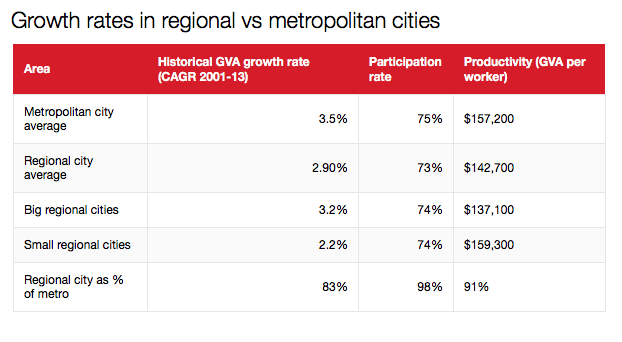Bust the regional city myths and look beyond the ‘big 5’ for a $378b return: Leonie Pearson
![]()
GUEST OBSERVER
Investing in regional cities’ economic performance makes good sense.
Contrary to popular opinion, new research out today shows regional cities generate national economic growth and jobs at the same rate as big metropolitan cities. They are worthy of economic investment in their own right – not just on social and equity grounds.
However, for regional cities to capture their potential A$378 billion output to 2031, immediate action is needed. Success will see regional cities in 2031 produce twice as much as all the new economy industries produce in today’s metropolitan cities.
Drawing on lessons from the UK, the collaborative work by the Regional Australia Institute and the UK Centre for Cities spotlights criteria and data all Australian cities can use to help get themselves investment-ready.
Build on individual strengths
The Regional Australia Institute’s latest work confirms that city population size does not determine economic performance. There is no significant statistical difference between the economic performance of Australia’s big five metro cities (Sydney, Melbourne, Brisbane, Perth and Adelaide) and its 31 regional cities in historical output, productivity and participation rates.

So, regional cities are as well positioned to create investment returns as their big five metro cousins. The same rules apply – investment that builds on existing city strengths and capabilities will produce returns.
No two cities have the same strengths and capabilities. However, regional cities do fall into four economic performance groups – gaining, expanding, slipping, and slow and steady. This helps define the investment focus they might require.
For example, the report finds Fraser Coast (Hervey Bay), Sunshine Coast-Noosa and Gold Coast are gaining cities. Their progress is fuelled by high population growth rates (around 2.7% annually from 2001 to 2013). But stimulating local businesses will deliver big job growth opportunities.
Similarly, the expanding cities of Cairns, Central Coast and Toowoomba are forecast to have annual output growth of 3.2% to 3.9% until 2031, building on strong foundations of business entries. But they need to create more high-income jobs.
Geelong and Ballarat have low annual population growth rates of around 1.2% to 1.5%. They are classified as slow and steady cities. But their relatively high creative industries scores, coupled with robust rates of business entries, means they have great foundations for growth. They need to stimulate local businesses to deliver city growth.
Get ready to deal
Regional cities remain great places to live. They often score more highly than larger cities on measures of wellbeing and social connection.
But if there’s no shared vision, or local leaders can’t get along well enough to back a shared set of priorities, or debate is dominated by opinion in spite of evidence, local politics may win the day. Negotiations to secure substantial city investment will then likely fail.
The federal government’s Smart Cities Plan has identified City Deals as the vehicle for investment in regional cities.
This collaborative, cross-portfolio, cross-jurisdictional investment mechanism needs all players working together (federal, state and local government), along with community, university and private sector partners. This leaves no place for dominant single interests at the table.
Clearly, the most organised regional cities ready to deal are those capable of getting collaborative regional leadership and strategic planning.
For example, the G21 region in Victoria (including Greater Geelong, Queenscliffe, Surf Coast, Colac Otway and Golden Plains) has well-established credentials in this area. This has enabled the region to move quickly on City Deal negotiations.
Moving past talk to be investment-ready
There’s $378 billion on the table, but Australia’s capacity to harness it will depend on achieving two key goals.
First, shifting the entrenched view that the smart money invests only in our big metro cities. This is wrong. Regional cities are just as well positioned to create investment returns as the big five metro centres.
Second, regions need to get “investment-ready” for success. This means they need to be able to collaborate well enough to develop an informed set of shared priorities for investment, supported by evidence and linked to a clear growth strategy that builds on existing economic strengths and capabilities. They need to demonstrate their capacity to deliver.
While there has been much conjecture on the relevance and appropriateness of City Deals in Australia, it is mainly focused on big cities. But both big and small cities drive our national growth.
Adjunct Associate, University of Canberra and author for The Conversation. She can be contacted here.
